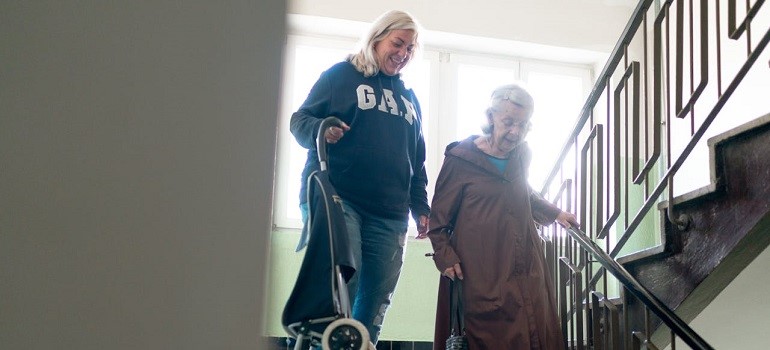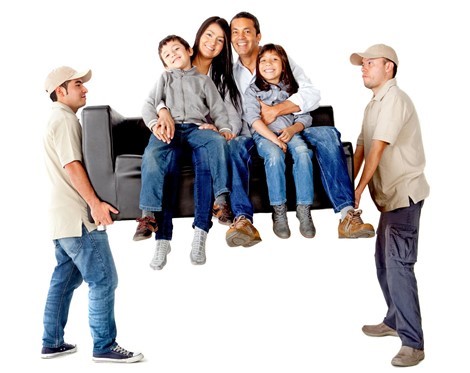Making space for an elderly parent can be daunting. For many seniors, it means leaving a place that they've called home for years, if not decades. Opening your home to them might feel like a kind gesture, and it is, but it can also be rather challenging for both you and your parent. You might need to adjust rooms, shift furniture, and coordinate care. It takes effort, time, and planning. The process may feel overwhelming, but it gets easier with clear steps and support from reliable Bay Area senior movers. Think about safety, comfort, and daily habits as you start to prepare your home for an elderly parent. Involve your parent in the process as much as possible. The more you plan now, the easier it becomes later. Every change should help your parent feel welcomed and secure.
Clear the clutter and organize with purpose
Start by removing clutter that could cause trips or confusion.
- Keep pathways wide and clear.
- Store cords out of the way.
- Move unnecessary furniture to create open walking areas.

Use the “four box method” to sort items in the following categories:
- keepsakes
- to sell
- for useful pieces
- or donations
Walk through each room with your parent and let them decide what stays. If some things are hard to part with, suggest storage units in Bay Area instead of disposal. Focus on function and access. Keep daily-use items within easy reach. Use clear labels for boxes and bins. Ask your parent what they use often and what they want near them. Respect their decisions, even if you don't agree. Sentimental value matters more than design. Give each item a place. That helps your parent adjust faster.
Make your entire home easier to move through
Adjust the layout of your home to support clear and safe movement:
- Add handrails in stairways and hallways.
- Replace round doorknobs with lever handles.
- Remove rugs that slip or bunch up.
- Widen walking paths by moving furniture against walls.
- Keep the floor clear of baskets, cords, and sharp edges.
Check that all rooms have enough lighting, especially at night and use brighter bulbs in dark corners or entryways. Place commonly used items at shoulder or waist level. Avoid forcing your parent to bend or stretch too much. Lower closet rods or add hooks where needed. Adjust seating areas to allow easy movement.
Create spots where your parent can rest if needed. Test each area for ease of movement with walkers or canes. Ask your parent what feels difficult or tiring and fix those issues first. These changes make day-to-day living simpler and reduce accidents. Many Bay Area residential movers also provide setup support and furniture placement for safer layouts.
Create a bedroom that supports comfort and rest
Set up a bedroom close to a bathroom if possible and avoid stairs if mobility is limited. Use a firm, supportive mattress and a bed with a height that’s easy to get in and out of. Add bed rails if needed for extra support. Additionally, you can consider the following accessibility commodities your parent would appreciate:
- Keep a phone or bell next to the bed for emergencies.
- Use soft lighting that doesn't strain the eyes.
- Motion-sensor nightlights help prevent nighttime falls.
Avoid placing furniture in the walking path and make sure drawers open easily and hold only essentials. Add a chair with arms to help with dressing. Store clothes and items at waist height. Ask your parent how they like their room arranged and do not decorate without their input. Familiar items bring comfort, so keep the space simple but personal. Choose calm colors and avoid visual clutter. Always keep water, tissues, and other small needs within reach.

Modify the bathroom for safety and ease of use
Bathroom changes can help prevent slips and injuries.
- Add grab bars near the toilet and inside the shower.
- Use non-slip mats on the floor and in the tub.
- Raise the toilet seat if needed for easier access.
Consider installing a walk-in shower. If not possible, use a shower chair and a handheld showerhead. Store soap, shampoo, and towels at an easy-to-reach height and make sure the bathroom door opens outward or is easy to unlock. Keep floors dry and place a basket for used towels. Brighten the lighting and install a nightlight. Mark hot and cold water clearly to prevent burns. Use lever-style faucets instead of knobs.
Ask your parent if they need help managing tasks. Make sure they can lock and unlock the door safely. These changes reduce risk and support independence. For larger renovations or moving help, Bay Area moving companies can offer relocation services suited to seniors.
Build a clear system for health and emergencies when you prepare your home for an elderly parent
Health needs often shape your parent’s day, so it helps to stay organized from the start. Begin by creating a simple system for tracking medications. Use a daily pill organizer and keep it in an easy-to-reach spot. Write down the names of their medications along with the correct schedule. Post a printed list on the fridge or in their room so it’s easy to find. Be sure to include allergy information, emergency contacts, and health conditions.

Store backup medication in a separate, clearly labeled container. If your parent struggles with memory, consider smart pill boxes or medication reminder apps. These tools are especially helpful with complex routines. It’s also a good idea to install a medical alert button or a smart speaker with call features. Place phones in accessible spots. If they wear hearing aids, check that spares and batteries are nearby. Set regular times to review medications, refills, and appointments. Doing this gives everyone peace of mind
Respect their habits and involve them in decisions
Every parent has long-standing habits that bring comfort, and those habits matter more than you think. So, when setting up their space, start by asking what they want to bring with them. That old chair or favorite blanket might not match your décor, but it helps them feel at home. Let them take the lead on arranging furniture or choosing where things go. Ask:
- how they like the TV set up
- what kind of lighting they prefer
- whether background noise bothers them.
Keep their routine in mind—especially with meals, sleep, or quiet time. If they take tea at a certain hour, make it easy to continue that. Avoid pushing too many changes all at once. Removing personal items without asking can feel upsetting. Let them maintain some control over their environment. Open conversations about comfort, privacy, and daily rhythm help them adjust. When they feel involved, settling in becomes easier and less stressful for everyone.
Be considerate of the sentimental and practical value some items might have for your parents
If possible, spend a few days with them in their home and learn what matters to them. That 20-year-old recliner might be ugly and tattered, but if that's where your father spends much of his waking time, take it with you. The 10-year-old TV might not be the latest in technology, but your mother knows the remote like the back of her hand. Some of those pictures or the knick-knacks might seem like junk to you, but they might be your parent's only connection to their childhood. For fragile pieces like antiques, trusted art movers San Francisco can assist with careful transportation.
Coordinate routines and shared living spaces
When a parent joins your household, routines shift, and that can impact everyone under the roof. That’s why it’s helpful to talk about how the day will look—together as a family. You can start by choosing times for meals, quiet hours, and shared tasks. Plan when the kitchen or bathroom gets used the most. Decide in advance who helps with grocery runs or cooking duties. Ask your parent what their ideal day looks like, then work around it.
Writing things down makes it easier to follow new routines. Also, build in time for rest and alone time, for both your parent and others in the house. Set boundaries early and kindly—like when noise should stay low or when visitors are expected. If your parent enjoys daily walks or a TV program, make space for that too. As routines take shape, you’ll see the household run more smoothly, with fewer misunderstandings or disruptions.
Use visual cues and tools when you prepare your home for an elderly parent
Sometimes small adjustments can make a big difference in how confident your parent feels each day. Start by labeling drawers, cabinets, and bins with large, easy-to-read print. A dry-erase board is helpful for jotting down appointments or reminders in plain view. Keep a large wall calendar nearby to track the week. Place clocks in bedrooms and common areas so they can check the time easily.

Nightlights in hallways and bathrooms add comfort and safety after dark. For memory support, you can color-code items or place clear signs—like “Bathroom” or “Pantry”—on doors. If needed, picture labels can make locations easier to identify. Keep switches and remote controls simple. Avoid overly complex tools that might frustrate them. Choose clocks that show both the time and date. If you use smart home tech, choose something they can test and understand. These little aids add up, helping your parent stay involved in their daily routine with more independence.
Take small steps to create a safe and welcoming home
Helping your parent move in doesn't have to happen all at once. In fact, starting small often works best when you prepare your home for an elderly parent. Focus on one room at a time and ask questions as you go. What helps them feel safe? What makes them feel comfortable? Listen closely to their answers. Keep routines steady and offer gentle reminders as needed. Modify spaces to reduce any physical risks. Talk with everyone in your household so they understand the changes too. Caring for a parent also means watching your own stress and limits. Use tools, checklists, or daily routines to stay on top of everything. Give your parent room to breathe, both physically and emotionally. Let them settle in at their own pace. Comfort and safety matter more than doing things perfectly. As their needs change, be ready to make new adjustments.
Tags
Subscribe to Upline Moving's Blog










